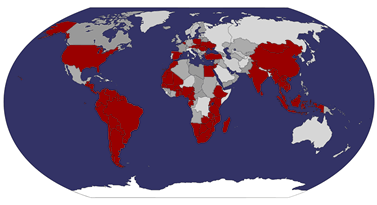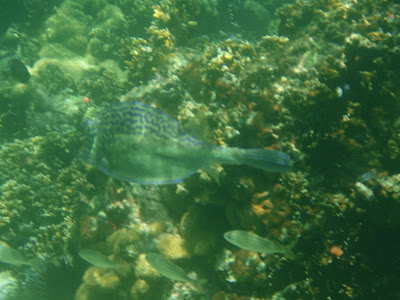Hello from Manaus, Brazil again--the internet here is relatively fast and cheap, and I needed an extra day to recover from our Amazon jungle outing, so we are back in the internet cafe uploading pictures and catching up on things. Here is another entry in our food porn series!
T&T:These first two pictures are from Tobago (the second T in "T&T," as the islands are often called).
Here is Andy in our Tobago hotel room assembling one our staple cheap meals: peanut butter and jelly! Shops in T&T had plenty of peanut butter...sadly, no countries we have been to since have sold it, though we have heard Guyana, our next stop, may.
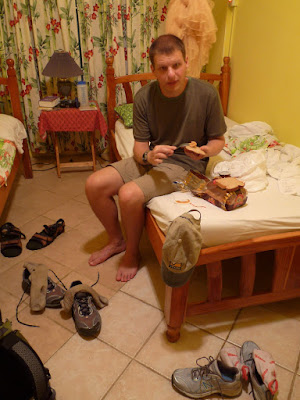
Here's array of street snacks from Tobago. From right to left you see yellow mangoes, purple mangoes, spiced mangoes, and an array of coconut- and sugar-based snacks. 5TT (less than $1) apiece. You'd see the same snacks in Trinidad, and similar ones in northern Venezuela, sometimes set up on unmanned tables in the middle of the road so you could drive by and grab a snack (and, I presume, leave money?)

At Maracas Bay in Trinidad, I finally tried Trinidad's famous "shark and bake," a fried white fish fillet (I don't think they really use shark anymore) on tasty fried bread (the "bake"--but trust me, it's fried) with a huge choice of toppings. I went for pineapple and white garlic sauce. And in the foreground you see Andy's aloo (potato) pie, potato wrapped in dough and fried. Also comes with condiments bar, Andy got something REALLY spicy on his.
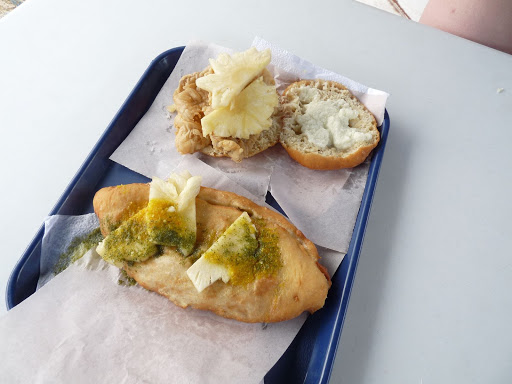
Me enjoying my shark and bake from Richard's, the best vendor on the beach. It was SO good.

Later, Andy had to get another aloo pie from a different vendor, and a mauby drink (kind of like root beer), another T&T specialty.
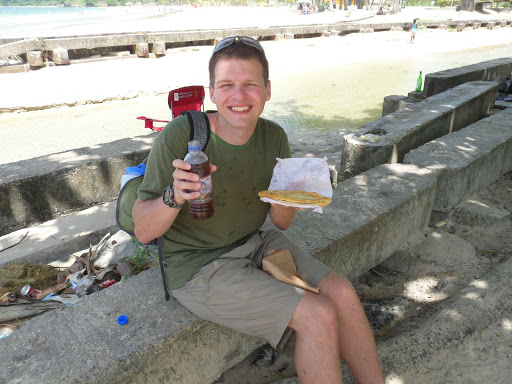
Of course, in Trinidad there was ice cream. We don´t have a pic of the best stuff we had, from a street vendor in the St. James area of Port of Spain, but this stuff wasn't bad either...we got coconut raisin and peanut swirl.
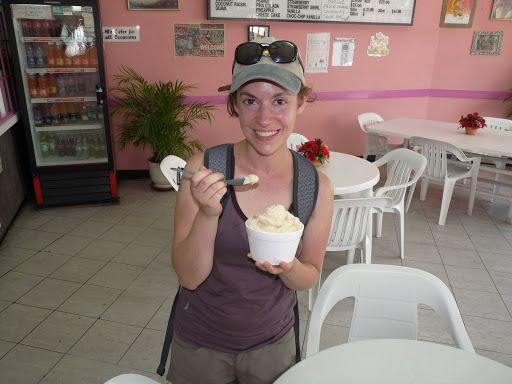 Venezuela:
Venezuela: Of course, there was ice cream in Venezuela as well. Here is the tiny, gasoline-powered soft-serve machine from which we bought cones for 2 bolivares (30 cents) each at the Carupano bus station.

When this lady saw Andy taking pictures of the ice cream machine, she insisted on posing for one with her cone, too.
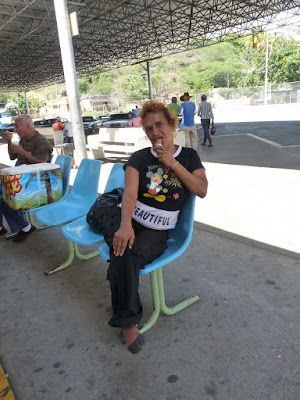
Here I am enjoying bread and cheese I had bought at a panaderia (bakery) in Santa Fe on our first double-decker bus trip in Venezuela.
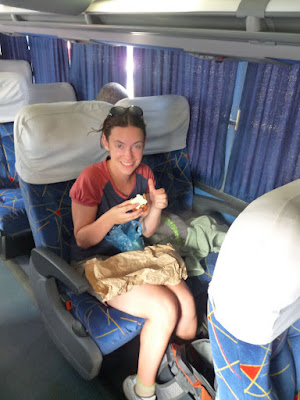
In Venezuela, people drink strong, sweet coffee out of tiny cups. It's called tinto. I don't usually drink coffee, but you know, when you are in Venezuela...

There was so much fun street food in VZ. Tons of empanadas filled with chicken, beef, and cheese that we have no pictures of. But here is some colorful sweet popcorn we got in Santa Elena.
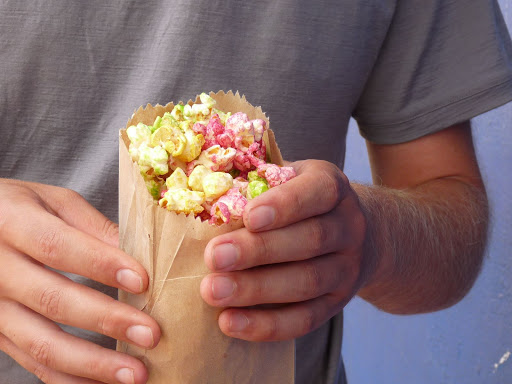
Santa Elena is a border town with Brazil, which means that that is where we realized that, unless we changed more money, we only had $8 US left in Venezuelan currency to spend on food for three days. But never fear, $8 can go far in Venezuela! We started by buying the biggest loaf of sliced whole wheat bread we'd ever seen at a panaderia. 38 slices for 15 bolivares ($2.50)!
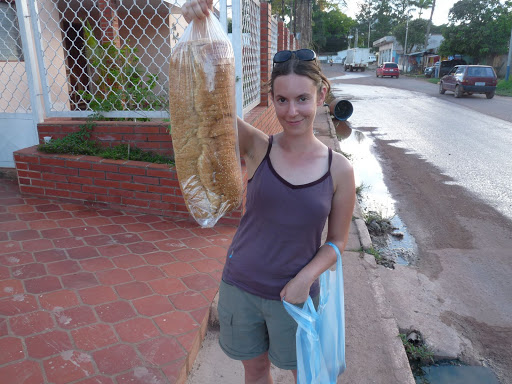
We also bought a jar of peach jam. But, no peanut butter to be found, so I got a hunk of cheese and ate jam-and-cheese sandwiches for breakfast, lunch, and dinner for a couple of days, with some of this nutella-like stuff on bread for dessert. Andy, meanwhile, indulged in some lovely canned ham, which he spread on the bread with a spork...
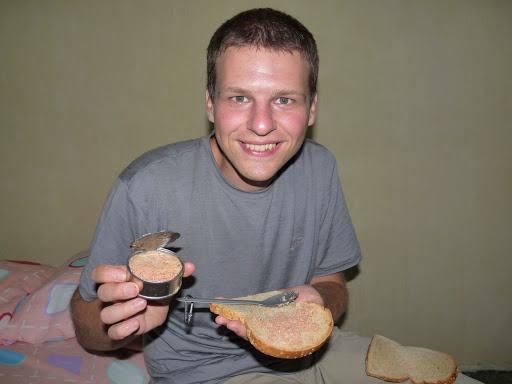
We ended up with enough cash left over that we were able to roam the town and feast all over on our last night in Venezuela--broccoli, chicken, and beef empanadas, banana-cinnamon cookies, ice cream, and peach nectar. (See, mom, I'm not starving!)
Brazil: Our first meal in Manaus, Brazil, was churrascaria, or all-you-can-eat Brazillian barbecue, at a restaurant called Bufalo.
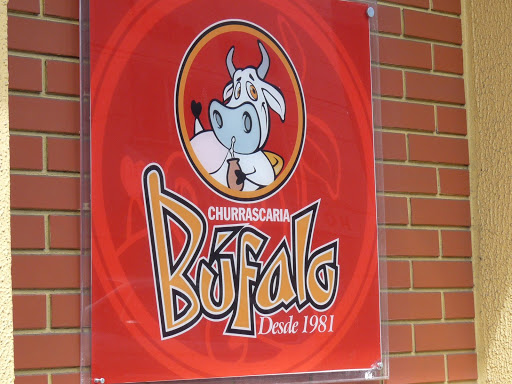
Our lunches were $13 apiece--astronomical compared to what we were living on in Venezuela, but way cheap compared to churrascaria in the U.S.
These pictures don't begin to do justice to the amount of food we ate, but you can get a taste.
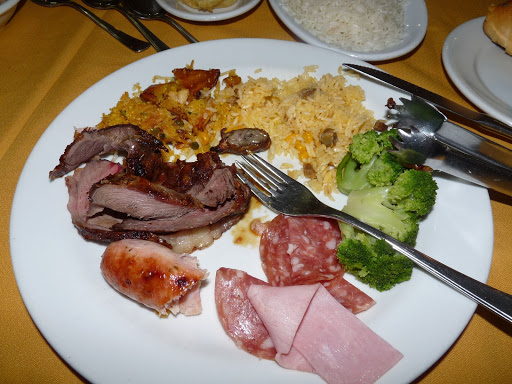
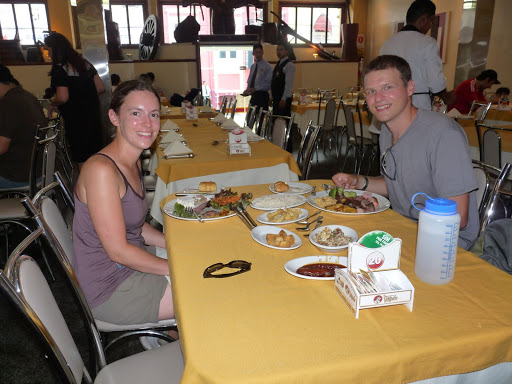
Then we went off into the rainforest for three days. It may have been buggy, hot, and uncomfortable, but we ate well.
Back in NYC, I loved to drink that expensive Sambazon acai juice, and one of my goals in heading to the Amazon was to see the acai tree, from whence the antioxidant-filled and tasty little purple berries come. Not only did I get to see the tree, but I got to see our boatman, Josenaldo, climb one, machete in his teeth, and then hack off a berry-laden branch!

We then took the branch back to our lodge in our canoe. I got to hold a berry. It was as hard as a rock.

Then Andy and I got to sit on the floor and shuck the branch, putting all the berries into a big pot!
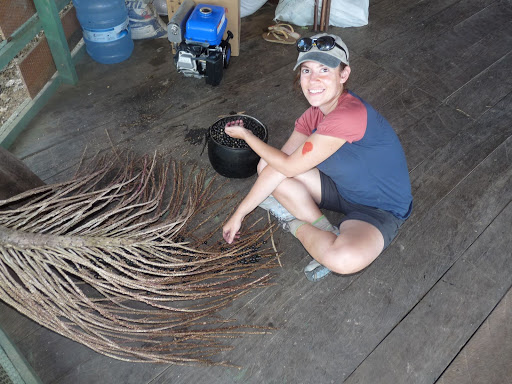
Later, at our overnight campout in the rainforest, Josenaldo (who was also our cook) boiled them for us to extract the juice, which we mixed with a bit of sugar and drank. Sooo good!
He also built a fire, made a makeshift grill out of branches, and cooked us a chicken for dinner. The next day, while we were out on an interminable hike, he battered and fried us chicken pieces. And on our final day, he balanced chicken halves over the fire in branches he'd hacked and shaped himself with the machete. This man was incredible. And so was his chicken.
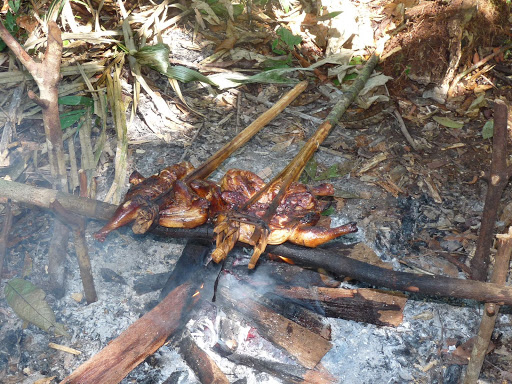
That's all we've got for now. In Brazil, we have also enjoyed the ddoce de leite (dulce de leche)-filled churros (cinnamon-sugar-coated donut-like sticks) that they sell on the square here near the beautiful opera house (and near our hotel). But at 2 reais ($1) a pop, we've had to limit our consumption. We're not in Venezuela anymore!

